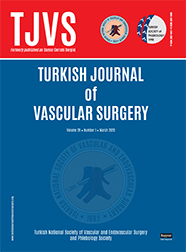
The Turkish Journal of Vascular Surgery
Yazarlar: Rıza TÜRKÖZ, Öner GÜLCAN, Hakan ATALAY, Orhan Saim DEMİRTÜRK, Levent OĞUZKURT, Alpay T SEZGİN, Bülent BOLAT, Fahri TERCAN, Mesut ŞENER, Ayad TÜRKÖZ
Konular:-
Anahtar Kelimeler:Thoracic aorta,Aneurysm,Circulatory arrest,Retrograde cerebral perfusion,Antegrade selective cerebral perfusion
Özet: Purpose: Although successful results have been reported about deep hypothermia and circulatory arrest (DHCA) in thoracic aortic aneurysms, the postoperative morbidity and mortality are still high depending on the location and the aortic pathology. The aneurysm cases operated on using DHCA were retrospectively reviewed. Methods: Forty-eight cases of thoracic aortic aneurysms were operated by one of the cardiovascular surgery teams in Baflkent University Adana Hospital between 2001 and 2004. Twenty-eight patients were operated on an emergency basis whereas 20 were operated electively. In all patients but three (92%) DHCA was used. Results: The average DHCA time was 28.1±14.1 minutes and in 5 patients it was between 50 to 60 min. In 26 patients retrograde and in 5 cases anterograde cerebral perfusion was used. The intensive care unit stay was 4.2±days, hospital stay was 8.5±4.5 days. No permanent neurological dysfunction occured although there was one transient neurologic dysfunction. Renal failure requiring hemodialysis occurred in three patients (6.25%). In six cases arrythmias requiring treatment was observed one of which needed a permanent pacemaker. Two of the patients died in the early postoperative period after weaning from cardiopulmonary bypass and five died in the intensive care unit. The hospital mortality rate was determined as 14.6%. Five cases were readmitted because of pleural effusion and two patients due to cardiac tamponade. No mortality was observed in the 17.8±9.7 months follow-up period. Conclusion: In our experience showed that retrograde cerebral perfusion use for 50 to 60 minutes in addition to DHCA in different types of thoracic aortic aneurysms is a safe method with an acceptably low mortality and morbidity. In five cases exceeding this time period, antegrade selective cerebral perfusion was used without complication. (Turkish J Vasc Surg 2004;13(3):21-24).